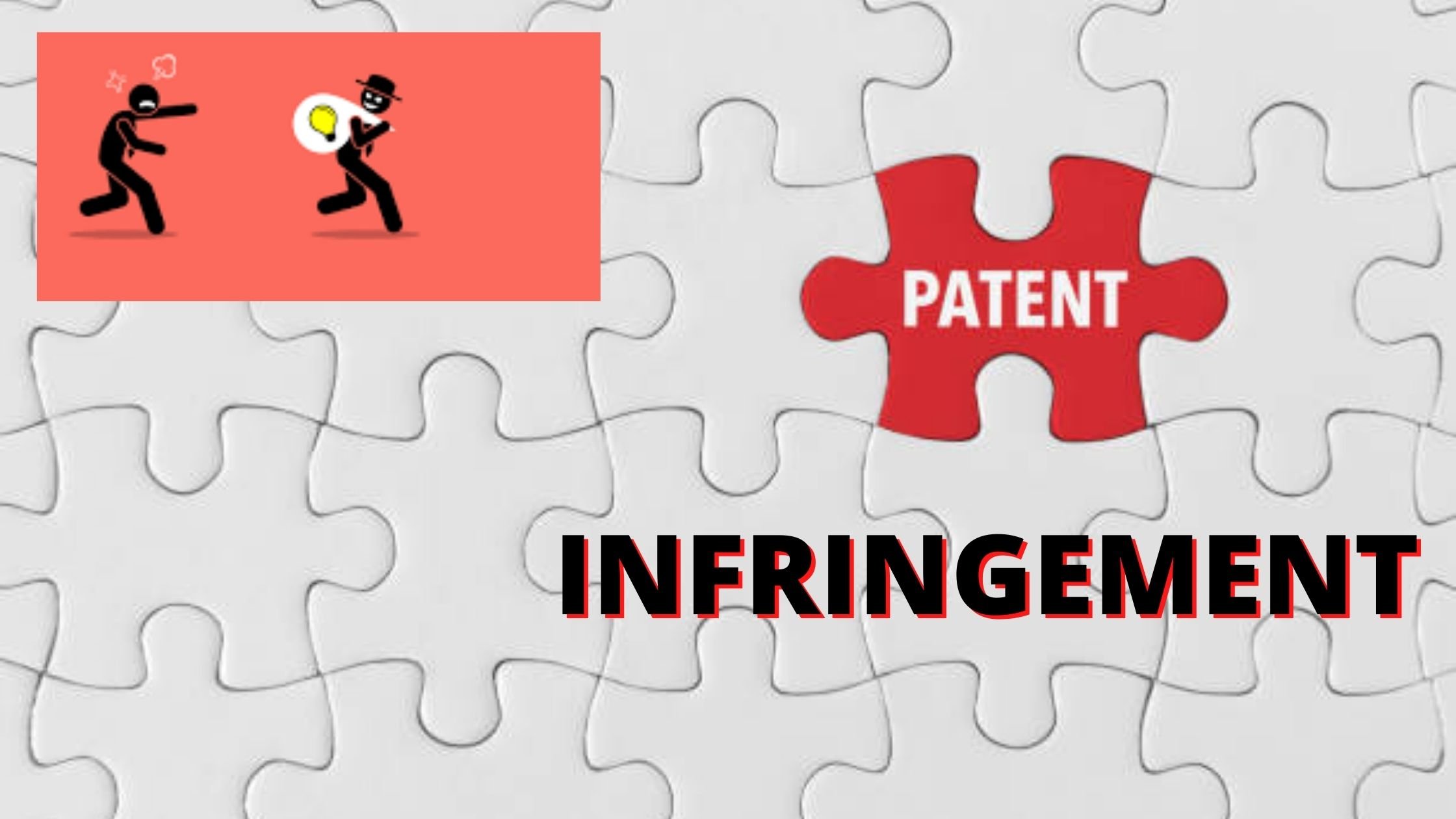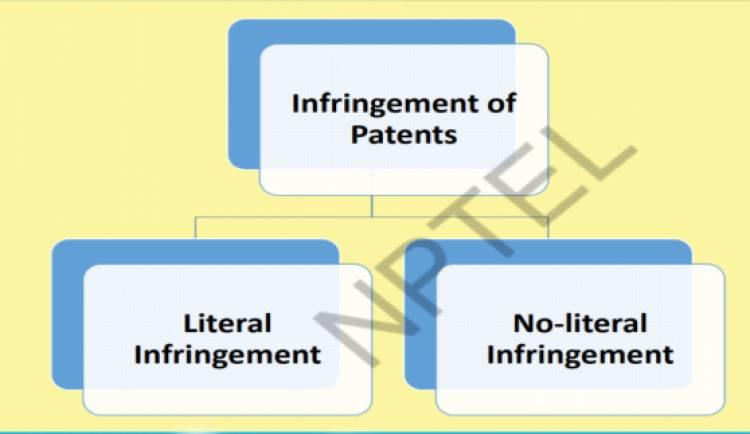All about Infringement of Patents?
Patent infringement means disobedience of the patentee rights in rem conferred under Section 48 of the Patent Act, 1970. There is no stipulation within the Patent Act, 1970 that defines infringement. So, we will see the patent laws of other common law states for direction. Example- Section 271 of U.S. Patent Act: According to Section 271 of this Act, The individual or entity without prior authorization produced, offers to sell, or trade any granted patented invention within the country or within the secured period imports such products into state or aggressively encourages infringement of a patented invention shall be answerable for infringement of that patent.

Enforcement of patent rights is often possible through judicial ways and administrative ways.
1. By Judicial enforcement (Suits referring to infringements)
a. violation suits
b. Declaratory suits
c. Suits against Groundless Threat
2. By Administrative Enforcement (Broader measure)
Patent Infringement:
Patent infringement means disobedience of the patentee rights in rem conferred under Section 48 of the Patent Act, 1970.
Definition of Infringement:
There is no stipulation within the Patent Act, 1970 that defines infringement. So, we will see the patent laws of other common law states for direction.
Example- Section 271 of U.S. Patent Act:
According to Section 271 of this Act, The individual or entity without prior authorization produced, offers to sell, or trade any granted patented invention within the country or within the secured period imports such products into state or aggressively encourages the infringement of a patented invention shall be answerable for infringement of that patent.
Also, anyone or entity offers to trade or trading within the state or imports into the states an element of a patented instrument, fabricate, amalgamation or composition, or substance for utilizing in working a patented process, having the concept this it’s specially prepared or adopted for infringement of such patent then shall behold accountable for contributory infringement.
Parties involved within the Infringement suits:
-
Patentee: The owner of the patent
-
Exclusive licensee- An individual or organization to which the license is permissible for a meticulous time is termed an Exclusive licensee. If the patentee has not involved in the procedures as a plaintiff then he should be equipped as a defendant. (Sec.109 of The Indian Patent Act, 1970)
-
Anyone who has acquired an obligatory license where the patentee neglected and didn't begin action at law within two months after receiving notice. (Section 110 of The Patent Act, 1970)
The appropriate forum to file infringement suit:
-
To file the infringement suit against an infringer, the plaintiff filed the suit in any court inferior to the district court to initiate the trial. But if the counterclaim is filed by the defendant after initiating the suit then that suit together with the counterclaim must be transferred to the state supreme court for the ultimate decision. (See Section 104 of the Patent Act )
-
Definition of District court is incorporated in the Code of Civil Procedure, 1908 under Section 2(4).
Place/Location of the Infringement Suit:
The place or location of the suit is provided in Section 20 of Code of civil procedure (C.P.C.), 1908- Suit shall be instituted within the court within the local limit of jurisdiction as per below situation.
• Where the defendant actually and voluntarily inhabits, or carries out a trade, or individually works for profit.
• In the case of the multiple defendants, any of the defendants are literally and voluntarily inhabits or carries out a trade or individually works for profit on its location. But, in such a situation, court leave must be taken or other defendants should accept this.
• Where a reason behind action completely or partially occurred.
Defense available to the defendant:
-
The defendant can take the defense of invalidity in an infringement suit by the revocation. anyone is curious about the Central Government or a defendant making the counter-claim of revocation in a very suit for the infringement.
-
On the opposite hand, the intellectual Property Appellate Board (IPAB) or just in case of a counterclaim in an infringement suit the honorable court has the authority to revoke the suit.
Grounds of revocation (Invalidity):
• Section 64(1)(a) of Patent Act, 1970- Another patent having the valid claim of earlier priority date comprises within the complete specification where the invention is claimed.
• Section 64(1)(c) of Patent Act, 1970- By the violation of the petitioner’s rights, the patent was acquired wrongfully.
• Section 64(1)(e) of Patent Act, 1970- The invention is publically known or publically used or published before the filing date of the invention, which implies the invention isn't novel.
Reliefs awarded to the plaintiff in Infringement suit:
Reliefs may be given to the plaintiff/petitioner within the kind of below two types,
1. Temporary Relief-
a. Order 39, Rules 1 & 2 of C.P.C., 1908
b. Mareva Injunction
c. Anton Piller Order
d. John Doe Order
2. Permanent Remedy- Section 108 of the Patent Act, 1970 (deals with a permanent remedy just in case of infringement suit filed by Plaintiff.
a. Injunction
b. Damages or account of profits
Concept of Innocent Infringer:
• Patent infringement is taken into account as a strict liability tort.
• Patent infringer becomes responsible for the damage or loss that arose to the truth patent owner in respect of any fault/issue by him.
• The law, hence, excludes an infringer from the given defense of innocence or no-fault.
Types of infringement:
There are two broad categories of infringement like literal infringement and non-literal infringement which shown below.

-
Literal Infringement-
• Cardinal rule of literal infringement is that this infringement incurred when the infringing goods comprise each & every scope /limitation captured in a minimum of one claim. This can be technically called an infringing claim which "reads on" the infringing goods.
• For example- A granted patent has an independent claim say claim 1. Claim 1 understand as, “a device which comprising A+B+C. Any goods/product comprised all three elements that A, B, and C would literally infringe the claim because the product is going to be reading on this claim.
• Hence the merchandise literally infringed 1. By Product comprises part A+B+C 2. The product comprises elements A+B+C+D+E and three. By product comprises a component P+Q+A+B+C.
-
Non-literal infringement :
• The Indian courts typically pursue the Approach of the United Kingdom (By the relevant case laws) for determining the scope and extent of non-literal patent infringement.
• There are cases in India where the Doctrine of Equivalents (DOE) which emerged from the US were argued within the Indian courts.
• If anyone wants to analyze the British approach then should be looking into the European Patent Convention.
Relevant case laws:
-
Koninklije Philips N.V. &Anr. v. Rajesh Bansal and
-
Koninklije Philips N.V. &Anr. v. Bhagirathi Electronics
These two cases are combined and common judgment was given by J. Mukta Gupta to the two defendants at the same time. The major issue, in this case, was about the ownership of the patent and the Essentiality of the suit Patent and its validity under Indian Patent Law. In this case, the court first time analyzed the Standard Essential Patents (SEP) of the impugned patents and held that the defendants were guilty of infringing the plaintiff’s patents. It has been proved to be a big step for the competitor specifically in the field of technology.
-
Larami Corporation V. Amron
This case is regarding literal infringement and involving toy water guns.
• The plaintiff Larami Corporation sought a declaration its “SUPER SOAKER” toy guns did not infringe the U.S. Patent No. 4,239,129.
• The defendant's Alan Amron and Talk To Me Products, Inc. (TTMP) counterclaimed that the "SUPER SOAKER" guns infringed the U.S. Patent No. 4,239,129 which was assigned to TTMP by the inventor.
In the first claim of the above-mentioned patent, it’s categorically specified that a toy gun has a chamber for a liquid which has the facility to manual operating for constructing the pressure on the said chamber for inserting the liquid.
The defendants' patented gun required that the chamber that contained liquid must be inside the elongated housing of the gun. • The SUPER SOAKER 20 (one of the products of the plaintiff) had an external water reservoir (chamber) that was detachable from the gun housing, and it was not contained within the housing. • The Court held that SUPER SOAKER 20 water gun did not literally infringe the claim.
-
Catnic Components Ltd. v. Hill & Smith Ltd.
In this case, Lord Diplock by rejecting the trial court’s holding which given by Whitford J.of infringement on the application of the “pith and narrow” doctrine and stated that a patent should be read in a “purposive” manner so as to spotlights on the fundamental functions of the patent.
He observed that the query occurred in each case that, whether an individual with substantial skill and knowledge in the art in which innovation was proposed to be exploited, would get to know that stringent obedience specific explaining words or terms used in a claim was be determined by the patentee to be an important prerequisite of the invention so that any variation will take place outer the monopoly claimed, even if it can not have any substantial effect on the working of the invention.
Conclusion:
From the above discussion, we have seen the types of infringement and what is the procedure exactly follows while dealing with patent infringement suits. Also one needs to look into relevant case law according to various concepts involved in patent infringement. There are various reasons hence nowadays that patent infringement suits are increased drastically and many big organizations use it as a business strategy to oppose the competitors for a specific duration by the various injunctions which awarded if proves the patent infringement.
know more about patents law, see the video below -
By -
Sushama Mhasurle












